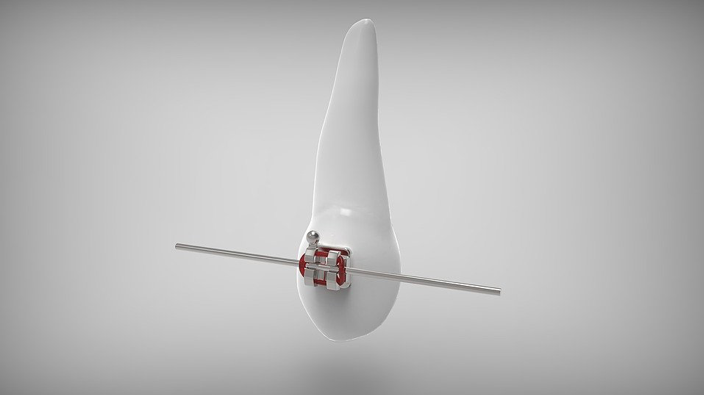How to Care for Different Types of Dental Braces
Once you get braces, you need to take proper care of your teeth. This can get quite difficult and cumbersome sometimes, but it helps ensure a healthy smile in the long run. Your braces can trap pieces of food within their tiny spaces. If you do not clean out those spaces, it can cause plaque buildup, which leads to numerous dental problems. To avoid it, you need to take good care of your braces and teeth, brush your teeth every day after meals, and rinse and floss once a day. This may seem excessive and tedious, but maintaining oral hygiene will help you avoid serious oral problems. You and your children should follow some extra steps to take care of braces. Today, various types of braces are available, depending on your preference. Here are some popular types of braces and methods to clean them:

(Source)
1. Metal Braces or Traditional Braces
Traditional braces have metal construction. They include wires and brackets that connect with your teeth and alter their positions. Archwires, with heat-based activation, is a new option if you prefer traditional braces. With these braces, teeth move into position quickly using your body temperature. This method of aligning teeth induces limited discomfort.
2. Ceramic Braces
Braces with ceramic construction are similar to traditional braces in shape and size. However, the only difference is that these braces feature ceramic, so they blend in with your teeth’s natural color. This makes them less noticeable.
Ceramic braces are as effective as a traditional metal brace for your teeth’ movement and properly positioning them. Ceramic braces are less noticeable, so they’re one step ahead of traditional braces and a great alternative if you still want to flash an attractive smile. Ceramic braces are an expensive option in contrast to traditional braces and require a rigorous cleaning routine. Without proper cleaning, they will stain.
3. Lingual Braces
Lingual braces are also like traditional braces because of their metal construction. Your dentist installs these braces inside of your teeth, which makes them invisible from the outside. This is the main benefit of installing these braces. For teeth alignment, these braces take a long time and are less effective. Some people also find lingual braces uncomfortable as the tongue is directly in contact with these braces. Another disadvantage is that these braces are hard to clean.
4. Invisalign Braces
These braces are very distinct and do not involve any wires or brackets. Manufactured from plastic, users place these custom-made aligners on their teeth for alignment. Invisalign are very easy to replace or remove, and you need replacement every two weeks for the treatment duration. Many patients need 18 to 30 different aligners to achieve the result they desire.
Taking Care of Different Types of Braces
1. Brushing and Flossing
Dentists usually advise using a small-sized toothbrush once you get braces. Using a toothbrush with a small head, you can easily clean out all areas, giving your better results. Usually, flat and soft nylon bristles are ideal for brushing hard-to-reach spots. However, dentists may also recommend specialized brushes with fine details.
Ideal Brushing Steps for any Type of Braces
- Start by brushing the top of the bracket or braces while aiming towards your tooth. Dental experts recommend that you brush in back-and-forth motions.
- Back-and-forth movements properly clean out the areas under the braces
- Now, brush the lingual and occlusal aspect of your teeth. Occlusal is the tooth’s biting side, and lingual is the area of the tooth facing your tongue.
- Brush in circular motions lightly to avoid damaging the braces.
2. Using an Oral Irrigator
To remove additional food particles and plaque from the mouth, you need to invest and purchase an oral irrigator. You can place this small device at your bathroom countertop. It comes with a tank that you need to fill with water before each use. Using moderate pressure, the irrigator will leave the wand through the water tank, which will remove food, plaque, and bacteria from the braces, teeth, and gum. With this device, you can easily enhance your oral hygiene without quitting flossing and brushing. You should use an oral irrigator once every week for extra cleaning.
3. Choose Your Diet Carefully
Your alveolar bones, teeth, and gum need high nutrient levels when you install braces. Teenagers and children need healthy foods for better growth. However, when you install braces, you need to avoid various beverages and foods to protect your wires and brackets. Orthodontists suggest some foods that you need to avoid while you have braces.
4. Visit the Orthodontist Regularly
When you install braces, you need to consult the orthodontist regularly for better adjustment results. When the orthodontist adjusts your teeth, you may feel slight pain or tightness. If this pain or tightness does not go away, you need to consult an orthodontist and share your problems. Similarly, if a part of your braces is broken or you face any other issue, schedule an appointment with your orthodontist immediately.

(Source)
Conclusion
If you want to install braces to straighten your teeth or have any other dental problems, consult NYC Dental Orthodontics. They offer some of the best professional orthodontist services in New York City. For appointments, contact us at (646) 760-8028.